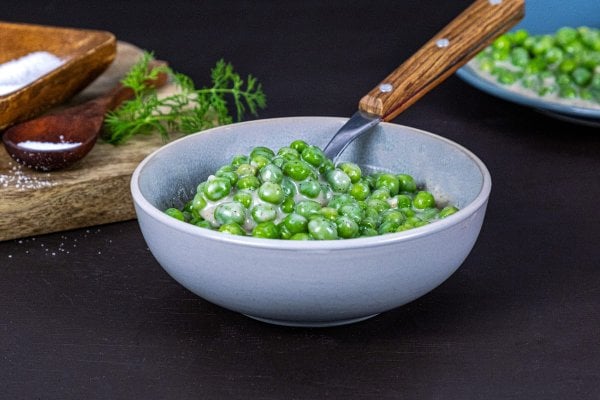This homemade Italian sausage recipe is based on years of recipe collection and tweaking. Whether you prefer to season your ground pork hot or make it mild and sweet, get ready to make the best Italian sausage for a pizza topping, spaghetti sauce, and more!

Table of Contents
ToggleWhy I Love Homemade Italian Sausage
When we butchered five pigs at once, we had an abundance of pork to make into sausage. We invested in some quality sausage-making equipment and spent days making different variations.
After many taste tests, some of our top favorites were breakfast sausage, German bratwursts, wild game sausage, Chinese dumpling sausage, and this homemade Italian sausage. We were so pleased with the results that we had to share, so you never have to buy store-bought sausage again.
You can grab all our sausage recipes with this downloadable PDF.
Since we have such a large family, we landed on a hot version of Italian sausage for the older family members and a mild mix for the little kids.
We keep large amounts of this on hand in bulk for delicious, quick meals. To make something special to kick off the weekend, we mix up a homemade pizza crust, and this sausage is among some of our favorite pizza toppings.
Adding Italian sausage to this freezer meal prep meatloaf recipe adds a special touch for busy weeknight meals. Italian sausage also tastes great as an appetizer or a side dish in these pizza pepper poppers.
Whether you use it in your favorite dish or cook it up all on its own, this Italian sausage is sure to be a hit and be asked for again and again.

Tips for the Best Homemade Italian Sausage
There are a few important things to note about homemade Italian sausage.
First, you need to dial in your preferred fat percentage. Lean sausage is great for some applications, especially those cooked into something else (think spaghetti), but it will be rather dry for eating as a bratwurst-style cased sausage.
We recommend that you aim for about 25% fat for really great sausage, but know that you can always adjust the fat percentage according to your tastes and desires.
We raise different breeds of pigs for different purposes. Kune Kune pigs are one of our favorite breeds because they provide a lot of amazing fat. We can use the fat to dial in our sausage ratio, and we render the rest into homemade lard.
Additionally, if you are working with a sausage stuffer, be sure to read your stuffer manual thoroughly. Some stuffers, especially the electric ones, are very exacting on a liquid amount that needs to be used in each recipe. Be sure to follow their recommendations precisely.

Homemade Italian Sausage Seasoning
Follow the chart below for the right seasoning measurements and the batch size of homemade Italian sausage that best suits your needs.
Homesteading Hack: Mild and sweet Italian sausage are interchangeable terms. If you want to make sweet Italian sausage, use the “mild version” measurements.
Keep in mind that these measurements are for dried herbs. Our method was to mix up enough for one pound of pork, form it into patties and cook it for a taste test. Once we had it perfected, we committed to a full 20-pound batch.
| Ingredient | 1 lb. Pork | 2 lbs. Pork | 20 lbs. Pork |
| Salt | 1 teaspoon | 2 teaspoons | 6 Tablespoons + 2 teaspoons |
| Black Pepper (Mild Version) | ¼ teaspoon | ½ teaspoon | 5 teaspoons |
| Black Pepper (Hot Version) | 1 teaspoon | 2 teaspoons | 6 Tablespoons + 2 teaspoons |
| Dried Parsley | 1 1/4 teaspoon | 2 1/2 teaspoons | ½ Cup + 2 teaspoons |
| Garlic Powder | 1 teaspoon | 2 teaspoons | 6 Tablespoons + 2 teaspoons |
| Onion Powder | 1 teaspoon | 2 teaspoons | 6 Tablespoons + 2 teaspoons |
| Dried Basil | 1 teaspoon | 2 teaspoons | 6 Tablespoons + 2 teaspoons |
| Paprika | ¾ teaspoon | 1 ½ teaspoon | 5 Tablespoons |
| Crushed Red Pepper Flakes (Mild Version) | ⅛ teaspoon | ¼ teaspoon | 2 teaspoons |
| Crushed Red Pepper Flakes (Hot Version) | ¾ teaspoon | 1 ½ teaspoons | 4 Tablespoons |
| Fennel Seeds | ¾ teaspoon | 1 ½ teaspoons | 5 Tablespoons |
| Oregano (use half for the mild version) | ¼ teaspoon | ½ teaspoon | 5 teaspoons |
| Thyme (use half for the mild version) | ¼ teaspoon | ½ teaspoon | 5 teaspoons |
Homesteading Hack: If you have a whole version of an herb and need it ground, use a spice grinder, mortar and pestle, or a clean coffee grinder.

How to Make Homemade Italian Sausage
Supplies Needed
- Meat Grinder – Because we use them on a large scale, we have burned through a few of these KitchenAid meat grinder attachments. They work better than a food processor if you are doing small batches, but we decided to upgrade to an industrial meat grinder.
- Sausage Casings – If you want to make sausage links, we recommend natural hog casings like these sausage casings. Make sure the sausage casing size matches the size links you want to make. Watch the video for the most straightforward example of how to prepare your sausage casings.
- Sausage Stuffer – After testing different sausage stuffers, we decided we prefer a hand-crank sausage stuffer over electric versions. We found that the hand crank is the easiest to control, and there are fewer parts that can break.
- Wrapping Materials – If you want to freeze your sausage links, you will need plastic wrap, freezer paper, and tape.
- Meat Bags – If you prefer your homemade Italian sausage in bulk, meat storage bags work great for the freezer.
- Bag Sealing Tape – To make sure your bags stay closed in the freezer, we highly recommend getting a roll of bag sealing tape. If you prefer to form patties and freeze them in an airtight container, that works great, too. Just bear in mind that they will have a shorter shelf life (about 2-3 months).

Ingredients Needed
- Pork – While pork shoulder is a popular choice, you can use any cut of pork for homemade Italian sausage. The important thing to remember is the lean-to-fat ratio. We’ve found that a 25% fat ratio is the best. In other words, 75% lean meat with 25% pork fat. You can create this ratio by using a simple food scale.
- Pork Fat – If you’re not butchering your own pigs, pork fat can usually be obtained from your local butcher.
- Red Wine Vinegar – This is our secret ingredient for the best homemade Italian sausage. Use 1 Tablespoon for a one-pound batch, 2 Tablespoons for two pounds or 1 ¼ cups for 20 pounds.
- Seasonings – Follow the seasoning chart above to make the mild or hot variation.






Step-by-Step Instructions
This base recipe is for making ground sausage for patties or crumbles. If you want to turn them into sausage links, you’ll want to follow those instructions below.
- Grind meat and desired fat using a meat grinder on a large grind followed by a small grind. Remember, the ideal ratio of meat to fat is about 25%.
- Blend all the spices with the vinegar and mix into the ground meat mixture until evenly distributed throughout.
- Label meat storage bags with their contents and the date, stuff the sausage mixture into the bags, and secure them with bag-sealing tape.
- Freeze for up to one year.
- Defrost in the refrigerator overnight and cook thoroughly until the sausage reaches 165°F.



For making homemade Italian sausage links, you’ll want to follow steps one and two above, then proceed with the following directions:
- Take ground pork mixture and, using an electric or hand-crank sausage stuffer and cleaned sausage casings, thread the casing onto the stuffer hose.
- Tie a knot at the end of the casing and begin filling the casings with the ground meat.
- To keep sausage from getting piled up in a heap, arrange it on the counter in a large spiral (as shown above).
- Once the entire casing is filled, tie off the other end and begin twisting into desired-sized links.
- Package up in a quantity that makes sense for your family. Wrap in a layer of plastic wrap and then again in freezer paper. Secure with tape.
- Make sure to label your packages and freeze them for up to one year.
- Defrost in the refrigerator overnight and cook thoroughly until sausages reach 165°F.

Storage and Leftovers
You can pre-cook your Italian sausage patties and store them in the freezer. To do this, cook until sausages reach 165°F (about 3-4 minutes per side).
Allow them to cool completely on a paper towel-lined plate. Transfer to a cookie sheet and flash freeze. Remove from the cookie sheet and transfer them to a freezer-safe container.
When ready to cook, reheat from frozen over medium heat with a teaspoon of oil in a frying pan until heated through.
Did you make this recipe? If so, please leave a star⭐rating and your comments in the recipe card below. This really helps us out, and we love to get feedback. Also, snap a photo of your homemade Italian sausage and tag us on social media @homesteadingfamily so we can see!

FAQ’s
Traditional Italian sausage is a mix of ground pork and pork shoulder. It also includes spices and seasonings. Fennel seeds and red pepper flakes are common, giving it a unique taste.
You’ll need a meat grinder or food processor to grind the pork. A sausage stuffer is also necessary for stuffing the sausage into casings. A mortar and pestle, spice grinder, or clean coffee grinder can help with grinding spices.
The beauty of homemade Italian sausage is that you can use any cut of pork. Pork shoulder is a popular choice because it is tender and flavorful.
Follow the chart found in this tutorial for the perfect spice blend for mild or hot Italian sausage.
Store cooked Italian sausage it in the fridge for 3-4 days or freeze it for up to 3 months. Keep it in a sealed container or bag. Label it with the date and contents.
Grilling and pan-frying are the best methods. Grilling sausage links add a smoky flavor and crispy texture. Pan-frying bulk sausage is quick and easy. Always cook to 165°F for safety.
Italian sausage is great in pasta sauces, gourmet pizzas, and spaghetti dishes. It adds flavor and texture to many recipes.
Other Posts You May Enjoy
- Easy Homemade Breakfast Sausage Recipe
- German Bratwurst
- Chinese Dumpling Sausage
- Wild Game Sausage
- Rendering Lard (or Tallow) for Homestead Cooking
- How to Cure Bacon

Homemade Italian Sausage Recipe
Equipment
- Meat Grinder
- Sausage Casings optional
- Sausage Stuffer optional
- Meat Bags
- Bag Sealing Tape
Ingredients
- 24 oz pork cubed
- 8 oz pork fat cubed
- 2 Tablespoons red wine vinegar
- 2 teaspoons salt
- 1/2 teaspoons ground black pepper use 2 teaspoons for hot sausage
- 2 1/4 teaspoons dried parsley
- 2 teaspoons garlic powder
- 2 teaspoons onion powder
- 2 teaspoons dried basil
- 1 1/2 teaspoons paprika
- 1/4 teaspoon crushed red pepper flakes Use 1 1/2 teaspoons for hot sausage
- 1 1/2 teaspoons fennel seeds
- 1/4 teaspoon oregano Use 1/2 teaspoon for hot sausage
- 1/4 teaspoons thyme Use 1/2 teaspoon for hot sausage
Instructions
For Sausage Patties
- Grind meat and desired fat using a meat grinder on a large grind followed by a small grind. Remember, the ideal ratio of meat to fat is about 25%.
- Blend all the spices with the vinegar and mix into the ground meat mixture until evenly distributed throughout.
- Label meat storage bags with their contents and the date, stuff the sausage mixture into the bags, and secure them with bag-sealing tape.
- Freeze for up to one year.
- Defrost in the refrigerator overnight and cook thoroughly until the sausage reaches 165°F.
For Sausage Links
- Follow steps one and two above.
- Take ground pork mixture and, using an electric or hand-crank sausage stuffer and sausage casings, thread the casing onto the stuffer hose.
- Tie a knot at the end of the casing and begin filling the casings with the ground meat.
- To keep sausage from getting piled up in a heap, arrange it on the counter in a large spiral (as shown in the video).
- Once the entire casing is filled, tie off the other end and begin twisting into desired-sized links.
- Package up in a quantity that makes sense for your family. Wrap in a layer of plastic wrap and then again in freezer paper. Secure with tape.
- Freeze for up to one year.
- Defrost in the refrigerator overnight and cook thoroughly until sausages reach 165°F.
Notes
- Make Ahead Directions – You can pre-cook your Italian sausage patties and store them in the freezer. To do this, cook until sausages reach 165°F (about 3-4 minutes per side). Allow them to cool completely on a paper towel-lined plate. Transfer to a cookie sheet and flash freeze. Remove from the cookie sheet and transfer them to a freezer-safe container.
- Reheating – When ready to cook, reheat from frozen over medium heat with a teaspoon of oil in a frying pan until heated through.


















